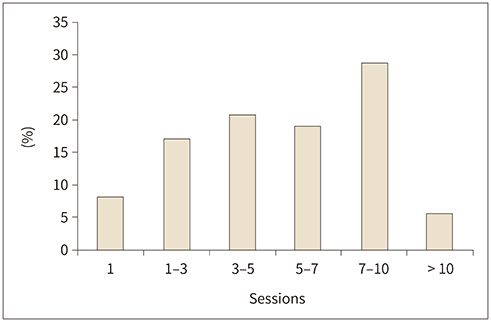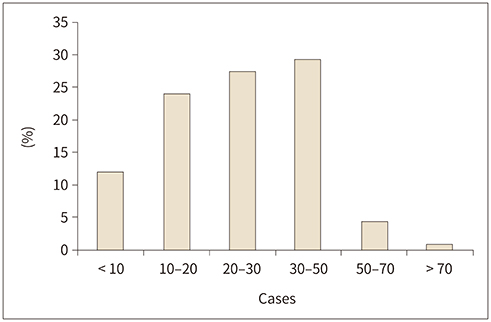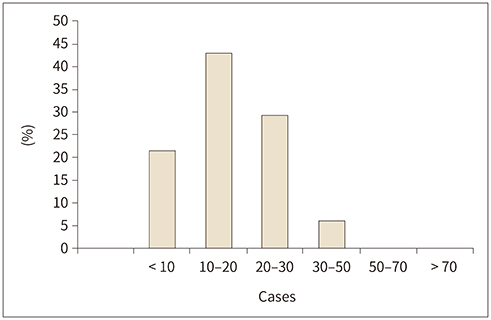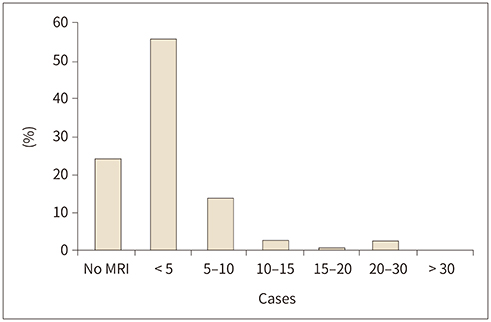J Korean Soc Radiol.
2019 Sep;80(5):919-929. 10.3348/jksr.2019.80.5.919.
A Survey on Current Trends of Breast Imaging Practices in Korea
- Affiliations
-
- 1Department of Radiology, Seoul National University Bundang Hospital, Seoul National University College of Medicine, Seongnam, Korea. kimsmlms@daum.net
- 2Department of Radiology, Seoul National University Hospital, Seoul National University College of Medicine, Seoul, Korea.
- 3Department of Radiology, Samsung Medical Center, Sungkyunkwan University School of Medicine, Seoul, Korea.
- KMID: 2459017
- DOI: http://doi.org/10.3348/jksr.2019.80.5.919
Abstract
- PURPOSE
This study aimed to analyze the current practices of breast imaging among Korean radiologists.
MATERIALS AND METHODS
We invited members of the Korean Society of Breast Imaging (KSBI) working as breast radiologists to participate in a survey on the current practices in breast imaging, and investigated how quality assurance (QA), medical audits, and imaging-histologic discordance were conducted.
RESULTS
The survey involved 312 members of the KSBI, and 116 (37%) responded to the 21 questions in the questionnaire. Most of the respondents were women (87%), aged below 50 years (82.7%), and working at university or tertiary hospitals (68.1%), who had varying levels of experience in breast imaging. Of the 116 respondents, 114 (96.6%) followed the Breast Imaging Reporting and Data System (BI-RADS) to interpret breast imaging. Out of 116, 72 (62.1%) interpreted 20 or more mammograms per day, 84 (72.4%) performed 10-30 breast ultrasound scans per day, and 65 (56%) interpreted fewer than 5 breast MRI scans per day. Among the respondents, 82% performed mammography QA, 76.9% evaluated imaging-histologic correlations, and only 38.9% performed medical audits.
CONCLUSION
The institutions and working patterns of breast radiologists were diverse. Although many respondents did not conduct medical audits, most of them followed BI-RADS when interpreting breast imaging, performing QA, and evaluating imaging-histologic correlations.
MeSH Terms
Figure
Reference
-
1. Cancer statistics. Incidence of breat cancer. 2014. Accessed Aug 14, 2017. Available at. http://www.cancer.go.kr/.2. Korean Statistical Information Service. Incidence of breat cancer. 2016. Accessed Aug 14, 2017. Available at. https://kosis.kr/.3. Jung KW, Won YJ, Oh CM, Kong HJ, Lee DH, Lee KH. Cancer statistics in Korea: incidence, mortality, survival, and prevalence in 2014. Cancer Res Treat. 2017; 49:292–305.
Article4. Korean Breast Cancer Society. Korean Breast Cancer Society breast cancer facts and figures 2017. Accessed Dec 26, 2017. Available at. http://www.kbcs.or.kr/sub02/sub04.html/.5. Healthcare Bigdata Hub. Breast MRI frequency 2017. Accessed Jul 2, 2017. Available at. http://opendata.hira.or.kr/.6. Centers for Medicare & Medicaid Services. Physician fee schedule CMS-1654-F. Accessed Nov 15, 2016. Available at. https://www.cms.gov/Medicare/Medicare-Fee-for-Service-Payment/PhysicianFeeSched/PFS-Federal-Regulation-Notices-Items/CMS-1654-F.html?DLPage=1&DLEntries=10&DLSort=2&DLSortDir=descending.7. AAARAD Survey FY16. Association of Administrators in Academic Radiology. Accessed Dec 26, 2017. Available at. https://wp.aaarad.org/wp/works/journal/.8. Kolb TM, Lichy J, Newhouse JH. Comparison of the performance of screening mammography, physical examination, and breast US and evaluation of factors that influence them: an analysis of 27,825 patient evaluations. Radiology. 2002; 225:165–175.
Article9. Park EC. Evaluation of organized cancer screening program in Korea. 2010. Accessed December 26, 2017. Available at. http://www.ndsl.kr/ndsl/search/detail/report/reportSearchResultDetail.do?cn=TRKO201100004109.10. McLelland R, Hendrick RE, Zinninger MD, Wilcox PA. The American College of Radiology mammography accreditation program. AJR Am J Roentgenol. 1991; 157:473–479.
Article11. Linver MN, Paster SB, Rosenberg RD, Key CR, Stidley CA, King WV. Improvement in mammography interpretation skills in a community radiology practice after dedicated teaching courses: 2-year medical audit of 38,633 cases. Radiology. 1992; 184:39–43.
Article12. Sickles EA, Ominsky SH, Sollitto RA, Galvin HB, Monticciolo DL. Medical audit of a rapid-throughput mammography screening practice: methodology and results of 27114 examinations. Radiology. 1990; 175:323–327.
Article
- Full Text Links
- Actions
-
Cited
- CITED
-
- Close
- Share
- Similar articles
-
- Current Trends in Breast Ultrasonography
- Current Practices in Breast Magnetic Resonance Imaging: a Survey Involving the Korean Society of Breast Imaging
- Current Understanding and Practices of Breast feeding by Mothers
- Optical Imaging of the Breast
- Developmen of Educational Program for Early Detection of Breast Cancer





